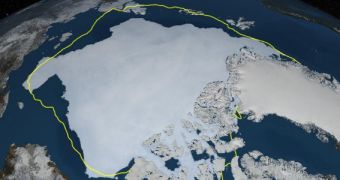A large-scale study based on data collected by multiple instruments aboard NASA satellites has shown that our planet's reflectivity level, or albedo, has decreased a lot faster, and by a wider margin, than initially thought. The change is largely caused by the yearly retreat of ices in the Arctic Ocean.
Over the past couple of decades, the amount of ice melting at and around the North Pole has increased yearly. More and more multi-layer, multi-annual ice is melting every summer, and insufficient amounts of ice form during the subsequent winters to replace what was lost.
As such, the amount of reliable ice – that endures over several years – is slowly declining, allowing for exposed ocean surfaces to gather more sunlight and heat over the summer. Additionally, waters in which polar ice has melted tend to be darker than usual, which means they trap even more heat.
Even when seen from space, the Arctic appears to be overall grayer than usual. This was observed in data from four Clouds and Earth's Radiant Energy System (CERES) instruments on NASA satellites.
The first CERES instrument was launched in December 1997 aboard the NASA Tropical Rainfall Measurement Mission (TRMM). Other spacecraft outfitted with this capability include the Terra and Aqua satellites, as well as the Suomi National Polar-orbiting Partnership (Suomi NPP) satellite.
These assets have collaboratively determined that the amount of energy the Earth absorbs from the Sun is increasing, while the amount of sunlight and heat reflected back into space is decreasing. Overall, the Arctic has warmed by 2 degrees Celsius (3.6ºF) over the past 45 years or so.
Since the 1970s, the total sea ice extent at the North Pole has decreased by a whopping 40 percent, say experts with the Scripps Institution of Oceanography at the University of California in San Diego, led by student Kristina Pistone and climate scientists Ian Eisenman and Veerabhadran Ramanathan.
Based on CERES data, the SIO team was able to establish that Earth's albedo decreased from 52 percent to 47 percent between 1979 and 2011. Reflectivity is measured on a scale from 0 to 100 percent, where 0 percent is a perfect black surface and 100 percent is a perfect white surface.
For comparison, fresh snow usually has an albedo of 80 to 90 percent, whereas the surface of the ocean boasts a reflectivity index of around 20 percent. There are multiple other factors that influence albedo readings, such as the mount of aerosols and soot in the atmosphere.
Details of the new investigation were published in the latest issue of the esteemed journal Proceedings of the National Academy of Sciences (PNAS). The work was supported through a grant provided by the US National Science Foundation (NSF).
The albedo reduction value established in this investigation is twice larger than estimated by previous models. This huge difference indicates that there must be some gaps in our knowledge of how sea ice influences planetary reflectivity, since some factors must have not been accounted for previously.
“It's fairly intuitive to expect that replacing white, reflective sea ice with a dark ocean surface would increase the amount of solar heating,” Pistone explains.
“We used actual satellite measurements of both albedo and sea ice in the region to verify this and to quantify how much extra heat the region has absorbed due to the ice loss. It was quite encouraging to see how well the two datasets – which come from two independent satellite instruments – agreed with each other,” she concludes.

 14 DAY TRIAL //
14 DAY TRIAL //